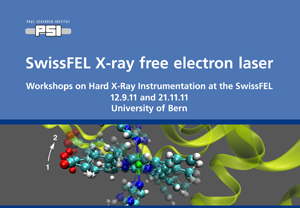Speaker
Dr
Andrin Caviezel
(Paul Scherrer Institut)
Description
X-ray diffraction is a promising tool to study the subtle interaction of the atomic lattice with the electronic degrees of freedom (long range charge, orbital and spin order) in strongly correlated electron systems. We have recently shown [1,2] that photo-induced structural phase transitions (e.g. a change of structural symmetry) in these materials can occur on time scales significantly faster than 200 fs the current time resolution at the SLS-FEMTO beamline. Optical data on a magnetoresistive manganite indicate [3] that the relevant structural dynamics may occur on a time scale as fast as ~70 fs corresponding to the period of the Ag Jahn-Teller stretching mode of the oxygen octahedra. Also in [3] even faster dynamics were observed (30 THz) attributed to orbital waves. In order to resolve such dynamics in greater detail a time resolution of <20 fs (FWHM) is required. Currently only an FEL capable of generating x-ray significantly shorter than 5 fs can offer such a time resolution provided that the jitter between the ultrashort excitation pulses (derived from an optical laser) can be kept below 10 fs or, alternatively, be measured shot-to-shot with this accuracy. In addition the high FEL flux will offer access to many Bragg reflections. This together with the appropriate time resolution will permit disentangling the atomic motions within the unit cell and give fundamental new insights to what is responsible for this strong correlation between lattice and the electronic order in these materials.
[1] P. Beaud, S. L. Johnson, E. Vorobeva, U. Staub, R. A. De Souza, C. J. Milne, Q. X. Jia and G. Ingold, Phys. Rev. Lett. 103, 155702 (2009)
[2] . Möhr-Vorobeva, S. L. Johnson, P. Beaud, U. Staub, R. De Souza, C. Milne, G. Ingold, J. Demsar, H. Schaefer, and A. Titov, Phys. Rev. Lett. 107, 036403 (2011)
[3] . Polli, M. Rini, S. Wall, R. W. Schoenlein, Y. Tomioka, Y. Tokura, G. Cerullo, A. Cavalleri, Nature Mat. 6, 643 - 647 (2007).
Authors
Dr
Andrin Caviezel
(Paul Scherrer Institut)
Mr
Paul Beaud
(Paul Scherrer Institut)
Co-authors
Dr
Gerhard Ingold
(Paul Scherrer Institut)
Dr
Jeremy Johnson
(Paul Scherrer Institut)
Mr
Sebastian Grübel
(Paul Scherrer Institut)
Dr
Simon Mariager
(Paul Scherrer Institut)
Prof.
Steven Johnson
(Physics Department, ETH Zürich)
Dr
Urs Staub
(Paul Scherrer Institut)

